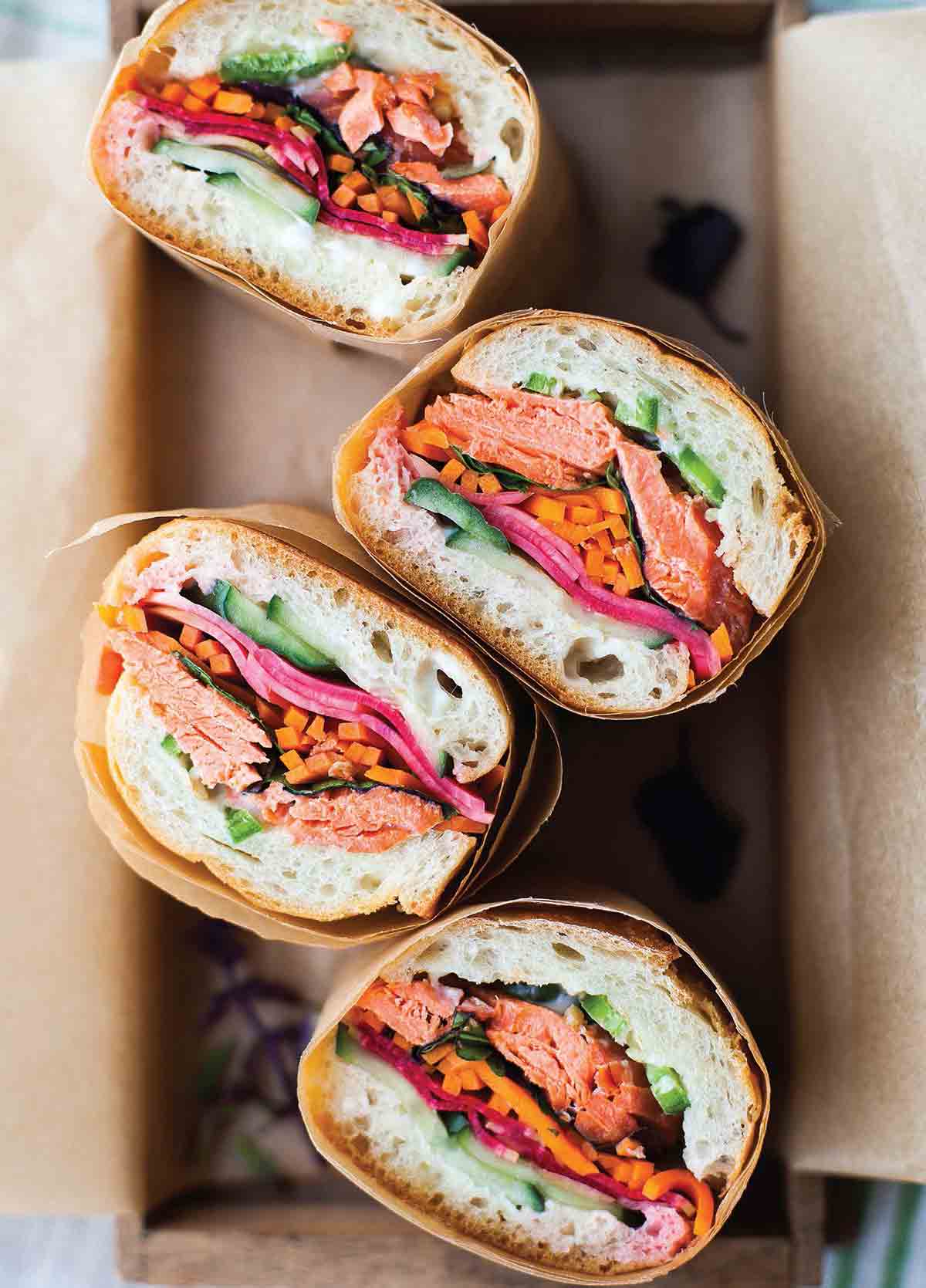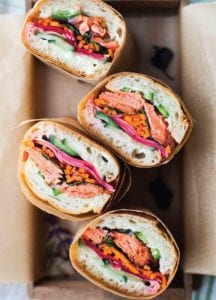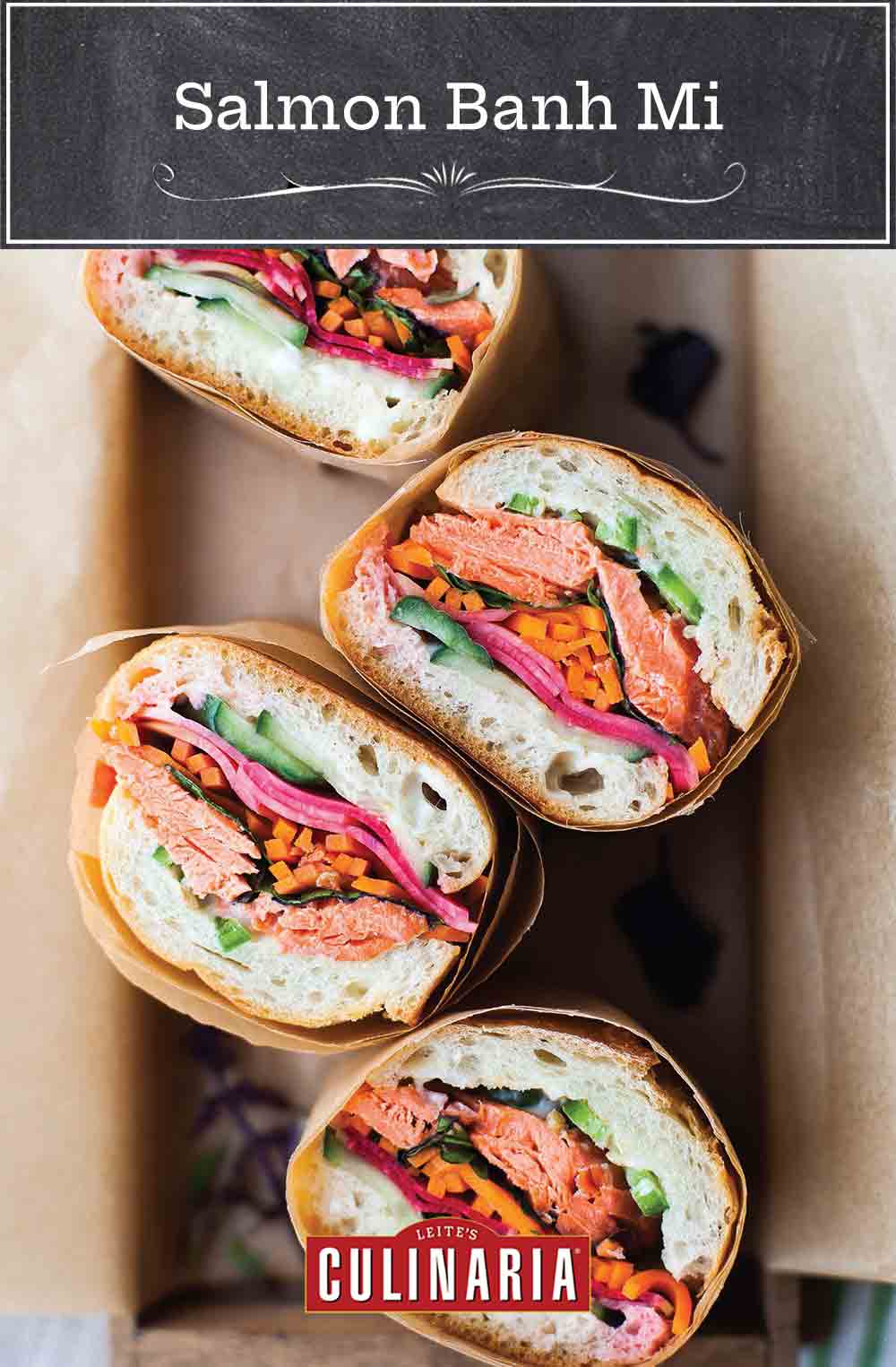
When I was a teenager, there was a particular sandwich from a nondescript corner store that I fell in love with. It cost all of two dollars, and it was amazing—full to bursting with wild, bright, sweet, savory flavors. It wasn’t until a few years ago that I realized that the cheap sandwich I bought in twos and threes to squirrel away in the fridge was a banh mi. There’s nothing traditional about putting salmon in banh mi, but I had summer in mind with this iteration. The Vietnamese baguette on which this is traditionally served uses both wheat and rice flours. A gluten-free baguette with rice flour would also work quite well. [Editor’s Note: We gotta say, a plain old traditional baguette works well in this sandwich, too, although a number of our recipe testers opted for softer sorts of breads for their salmon banh mi and were quite content.]–Kimberley Hasselbrink
LC Why Banh Mi? Note
Why make banh mi at home? Uh, why not? In the words of one of our recipe testers, “When I saw that this banh mi recipe called for salmon instead of the usual pork, chicken, or tofu, I was intrigued. Plus, I’ve never made banh mi.” For those unacquainted with the traditional Vietnamese sandwich that’s been trending oh so recently in New York City and elsewhere, it’s a crusty baguette crammed with pickled carrots, daikon radish, and cucumber along with pork belly or other meats–or, as in this recipe, swanky spiced salmon. We’re pretty certain you’ll not find this type of banh mi anywhere else.

Salmon Banh Mi
Ingredients
For the pickled vegetables
- 2 medium carrots
- 4 ounces (about a 4- to 6-inch [10- to 15-cm] chunk) daikon radish
- 1/3 English cucumber
- 1/2 cup distilled white vinegar
- 1/4 cup natural cane sugar
- 1/2 teaspoon fine sea salt
For the aioli
- 1/2 cup mayonnaise
- 1 small clove garlic, finely minced
- Zest of 1/2 lemon or lime
For the salmon
- 1/4 cup boiling water
- 1/4 cup lightly packed brown sugar
- 1/4 cup fish sauce
- 1 tablespoon store-bought or homemade Sriracha sauce
- 1 teaspoon low-sodium tamari
- 3 cloves garlic, finely minced
- One (16-ounce) skinless wild salmon fillet, (preferably thin), pin bones removed, salmon cut into 4 equal pieces
For the sandwiches
- 1 French, Vietnamese, or gluten-free baguette, sliced crosswise into 4 equal pieces (5 to 6 inches [13 to 15 cm] each)
- 1/4 cup loosely packed cilantro leaves
- 1/4 cup loosely packed Thai or regular basil leaves
- 1 small jalapeño, seeded and very thinly sliced (optional)
Instructions
Make the pickled vegetables
- Using a julienne slicer or a sharp knife, cut the carrots into long matchsticks. With a mandoline or the same sharp knife, slice the radish as thinly as possible. Cut the cucumber diagonally into slices about 1/8 inch thick.
- Combine the vinegar, sugar, and salt in a medium bowl, whisking vigorously until the sugar is dissolved or very nearly dissolved. Add the carrots, radish, and cucumber. Stir and toss to evenly coat the vegetables. Set aside at room temperature for 30 to 60 minutes.
- Drain the vegetables and place them in an airtight container in the refrigerator until you’re ready to serve. (You may have pickles left over after making the banh mi. They should keep in the fridge for up to 3 days.)
Make the aioli
- Combine the mayonnaise, garlic, and lemon or lime zest in a small bowl. Cover and refrigerate for at least 20 minutes and up to 1 day to allow the flavors to meld.
Make the salmon
- In a bowl, whisk together the boiling water and the brown sugar, stirring until the sugar dissolves. Add the fish sauce, Sriracha, tamari, and garlic and stir to combine. Set aside about 3 tablespoons marinade to drizzle over the sandwiches later. Transfer the rest of the marinade to a shallow baking dish and let cool to room temperature, 10 to 15 minutes. Place the salmon slices in the marinade, turning to coat both sides. Cover and refrigerate for about 1 hour, flipping the salmon halfway through.
- Preheat the broiler. Remove the salmon from the marinade and place on a broiler pan or in a shallow metal baking dish. Broil 6 inches from the heat source until the salmon is golden brown on the surface, crisped at the edges, and cooked through to the desired doneness, roughly 6 to 8 minutes, depending on the thickness.
Assemble the banh mi
- Split 1 baguette portion in half and hollow out some of the bread inside the crust. Brush both sides of the baguette’s interior with some aioli. Pile on a generous quantity of the pickled vegetables onto the bottom half of the baguette and top with 1 tablespoon cilantro and 1 tablespoon basil. Top with 1 piece salmon, breaking it into chunks, and top with some jalapeño slices, if using. Drizzle a little reserved marinade over everything and top with the other baguette half. Repeat with the remaining ingredients to make a total of 4 sandwiches. Serve immediately.

Nutrition
Nutrition information is automatically calculated, so should only be used as an approximation.
Recipe Testers’ Reviews
This salmon banh mi was unlike any banh mi one would find in stores or restaurants. And what a yummy banh mi this turned out to be. I’ve always wanted to make banh mi, but just never got around to it. We also live in an area where they are so easy to get and so very, very affordable.
We loved these salmon banh mi, despite their messiness. The salmon on its own was a little salty, but when combined with the garlic aioli, pickled vegetables, fresh herbs, and baguette, it was excellent.
When I saw that this banh mi recipe called for salmon instead of the usual pork, chicken, or tofu, I was intrigued. Plus, I’ve never made banh mi. My entire family loved this recipe, including my daughter, who normally won’t touch salmon.
In looking at how long each section of this salmon banh mi recipe needed, I decided that preparing the salmon first was the rational approach since that needed a full hour to marinate. The marinade comes together very quickly and I would have had it all in the fridge in 10 minutes, except I needed to remove the skin from my salmon, which added 5 minutes.













I’ve made this recipe twice! I lived in Vietnam for five years as a child and although this is an unorthodox salmon recipe, it brought back some of the complex flavors I so vividly remember. It can get messy so don’t forget your napkin! I would suggest not cutting the baguette piece fully in half, so that the bread can cling together and keep the ingredients inside. Hollowing out the bread, as the recipe indicates, is very important! Will definitely try it again soon!!
I envy you your time in Vietnam, Vera. What a spectacular formative experience in so many ways, especially in terms of the cuisine!
Reads like a winner EXCEPT for the bread part…gluten free bread is pretty terrible and I know of no g-f bolillos or baguette (even tho latter is rejected above)…I suggest and will try a good sized corn tortilla?
Ruth, the thing is, a gluten-free baguette is traditional for banh mi. It’s made with rice flour, which results in a much lighter, airier, crisper baguette. I know exactly what you mean in terms of gluten-free breads being just, well, ick. But in this case, I dare say there may be an exception if you have the real Vietnamese deal and not some recently created hybrid baguette of guar gum and pea flour and Lord knows what else. At any rate, of course there are alternate options for the firmament of the sandwich. I would actually keep with the original flavor profile of the recipe and encourage you to consider turning this into a summer roll by wrapping it all in a rice wrapper. Or, because I prefer the path of least resistance, I’d turn this into a plated salad and simply omit any manner of bread. Whatever you choose, let us know how it goes!
For banh mi sandwiches, you don’t want a thick crusty baguette which overwhelms the sandwich and puts the focus on the bread, not what’s inside the bread. It’s also really hard to eat. Go for a roll with a light crispy crust. Something like a Mexican bolillos or those torpedo rolls that one usually finds in a Portuguese bakery (sorry I never learned the name, but it was so much like the Vietnamese French bread that it was what my mother used to make banh mi sandwiches when we lived in suburban CT and there was not a banh mi shop in sight).
Works for us, ATNell. A lot of our testers said the exact same thing, as you’ll see in their comments above. But thanks ever so much for chiming in and sharing your insights…